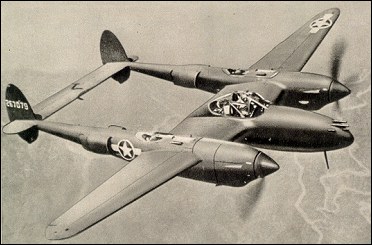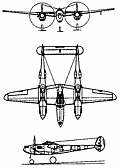 |
Lockheed P-38 Lightning1939 |  |
| FIGHTER | Virtual Aircraft Museum / USA / Lockheed |
 |
The P-38 was the only American fighter built before World War II to be still in production on VJ Day. Developed through many successively improved versions, the Lightning was used in all US combat zones as a high- and low-altitude fighter, fighter escort, bomber, photographic-reconnaissance aircraft, low-level attack and rocket fighter, and smoke-screen layer. The first aeroplane developed from the start as a military type by Lockheed, the P-38 was designed to meet an Air Corps specification issued in 1936. The XP-38 prototype flew for the first time on 27 January 1939 and the first YP-38 service-evaluation aircraft of a limited procure-ment order for 13 was delivered to the USAAF in March 1941. The P-38D was the first version of the Lightning to go into service in the war - an aircraft of this mark was the first American fighter to shoot down an enemy aeroplane, flying over Iceland a few minutes after the US declared war on Germany. The P-38L was the last fighter version to see combat service, which took in the final stages of the Pacific War. Two P-38L Lightnings escorting a Boeing Fortress were actually the first Allied fighters to land on Japanese soil after the surrender. Built in large numbers throughout the war, the Lightning - as the type was first named by the RAF- appeared in 18 variants. The RAF, however, received only three of 143 aircraft similar to the P-38D which followed the P-38 into production - their performance being unacceptable to the RAF. This resulted from the fact that Lockheed were not permitted to export aircraft with turbocharged engines, making it necessary to install the unsupercharged 775kW Allison V-1710-33 engines which had proved to be underpowered in the XP-38 prototype. P-38D in US service differed from the original P-38 by introducing self-sealing tanks and tail-unit revisions to overcome buffeting. P-38E had armament changes and were followed by the P-38F with more powerful engines and underwing racks (between engines and fuselage nacelle) for drop-tanks or weapons: late production examples introduced Fowler-type flaps which had a 'droop' setting to enhance manoeuvrability. P-38G had more powerful engines, as did the P-38H and -38J - the latter introduced an improved cooling system and powered ailerons. Most extensively built version was the P-38L (3,923), equipped to carry rocket projectiles beneath the outer-wing panels. Some P-38J were converted to serve as two-seat 'Pathfinders'; some P-38L as P-38M night fighters or TP-38L two-seat trainers; and other versions included F-4 and F-5 photo-reconnaissance aircraft. The Lightning is remembered especially as a long-range escort for Eighth Air Force bombers making deep-penetration daylight attacks on targets in Germany, as well as for the long-range interception and destruction of the Mitsubishi G4M1 (Betty) bomber carrying Japan's Admiral Isoroku Yamamoto.

|  COMPANY PROFILE | |||||||||||||||||||||||||||||||||||||||||||||||||||||||||||||||
 |

|

